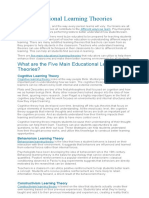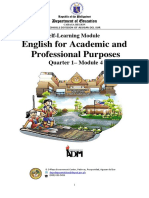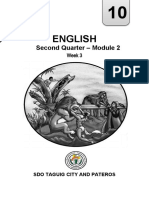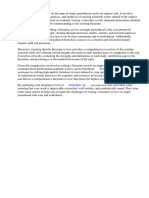English 6 3rd Quarter Week 1
English 6 3rd Quarter Week 1
Uploaded by
Stephanie ClemeñaCopyright:
Available Formats
English 6 3rd Quarter Week 1
English 6 3rd Quarter Week 1
Uploaded by
Stephanie ClemeñaCopyright
Available Formats
Share this document
Did you find this document useful?
Is this content inappropriate?
Copyright:
Available Formats
English 6 3rd Quarter Week 1
English 6 3rd Quarter Week 1
Uploaded by
Stephanie ClemeñaCopyright:
Available Formats
English 6 3rd Quarter Week 1
Making a Stand on an Informed Information
Part of your lesson today is distinguishing fact from opinion. You may have learned this in the past. So, let us look
back and see if you can still remember.
Directions: Read and study the following statements. Write F if the statement is a FACT and O if it is an OPINION.
_____1. Dogs cannot sweat through their skin.
_____2. Cats are the most charming pets in the world.
_____3. Cats have five toes on each front paw, but only four toes on each back paw.
_____4. Dogs are the best animal companion.
_____5. Dogs’ emotions are revealed by their facial expressions as well as the movement of their ears.
_____6. Cats' bodies are extremely flexible.
_____7. Cats have whiskers.
_____8. All cats love cuddles.
_____9. Dogs are better pets than cats.
_____10. Dalmatians are born spotless.
Having a pet can improve your mood.
What kind of statement is this? Is this an opinion or a fact?
Yes, you are right! This is a statement of opinion.
Do you agree with the informed opinion that having a pet can improve one’s mood?
What pieces of evidence were cited to support such opinion?
What is your stand on this informed opinion?
What is It?
An informed opinion is a person’s belief, idea, or way of thinking about something based on information
gathered. This type of opinion is formed by gathering ideas from different points of view.
Example: Having a pet can improve your mood.
A stand is a person’s attitude towards a particular issue or opinion. A person’s stand may either support or
contradict an idea expressed in an informed opinion.
Example: Owning a pet can help reduce stress you are feeling amid the health crisis. According to studies,
spending time with your pet can trigger an increased level of oxytocin, also known as the "love hormone." Making a
stand means making a firm position in defense or opposition of an informed opinion. You need to support your
statement by providing evidence like proof or testimony based on facts.
Below is a guide in making a stand:
Decide on your stand. After studying the informed opinion, it is time
Decide your stand. After studying the informed opinion, it is time for you to decide whether to agree or
disagree with the author’s statements. Your decision will depend on your judgement, feelings, or even from your
personal experiences about the topic. However, you must remember that though you are free to choose a stand, the
proofs or facts you have gathered must always be your bases in making a stand.
The sample flowchart below will guide you in deciding on your stand:
Assessment
Activity 1: Got It? Line It!
Directions: Identify the correct word to make the sentence coherent. Write your
answers on your answer sheet.
1. Students should be quiet during the online performance, (however, in fact) applause at the end is allowed.
2. Mr. Bernardo agreed to meet the workers with questions regarding the contract. (He, It) is interested in
hearing their concerns so that they can adjust to the new normal.
3. Doctors, nurses, and other front line workers in the hospitals work very hard during this crisis. The (faculty
members, health workers) risk their lives in saving their patients.
4. During weekends, children usually enjoy running outside with friends, swimming at the beach, and playing
online games. They also like (to go visit, visiting) their grandparents especially if they live far apart from
each other.
5. (As long as, Before) you strive to achieve your goal, nothing is impossible.
Activity 2. Match Me!
Directions: Match the definition given in Column A with the corresponding part of the report structure found
in Column B.
A B
1. This part summarizes the report’s main points. a. Table of Contents
2. The report title and purpose, and the student’s
name are found here. b. Introduction
3. It introduces the topic, its background and c. Conclusion
significance.
4. A list of sections and subsections indicating which d. Reference List
page each section begins is placed here.
5. Any sources you have referred to is listed here in e. Title Page
alphabetical order.
f. Page Number
You might also like
- Five Educational Learning TheoriesDocument4 pagesFive Educational Learning TheoriesKim Rose Borres100% (1)
- Positive Psychology Handout and MatrixDocument2 pagesPositive Psychology Handout and MatrixDana Alyssa LontocNo ratings yet
- Making A Stand On An Informed OpinionDocument34 pagesMaking A Stand On An Informed Opinionclervy joy villon100% (2)
- Duolingo Reading Section - ModulDocument49 pagesDuolingo Reading Section - ModulBuku DuniaNo ratings yet
- English Shs Eappmodule4Document14 pagesEnglish Shs Eappmodule4Alethea Sanchez100% (1)
- Eapp M4Document15 pagesEapp M4Lore Isabel Mendoza PaclebNo ratings yet
- Eapp M41Document23 pagesEapp M41Justine EnriquezNo ratings yet
- English: Quarter 3 - Module1 Present A Coherent, Comprehensive Report On Differing Viewpoints On An IssueDocument31 pagesEnglish: Quarter 3 - Module1 Present A Coherent, Comprehensive Report On Differing Viewpoints On An IssueAlbert Lopez100% (1)
- Examples of StrategiesDocument58 pagesExamples of StrategiesMariel EfrenNo ratings yet
- LS1 Eng LAS (Parts of A Simple Sentence)Document14 pagesLS1 Eng LAS (Parts of A Simple Sentence)als midsayap1No ratings yet
- English4 q3 Mod4 Main Idea Key Sentences and Supporting DetailsDocument12 pagesEnglish4 q3 Mod4 Main Idea Key Sentences and Supporting DetailsRebecca AbedesNo ratings yet
- Q4 English9 AS6-TakingStand FINALDocument4 pagesQ4 English9 AS6-TakingStand FINALchipskangkong021No ratings yet
- English SHS Eappmodule4Document15 pagesEnglish SHS Eappmodule4JAMES HENSONNo ratings yet
- Develop Paragraphs That Illustrate Each Text TypeDocument9 pagesDevelop Paragraphs That Illustrate Each Text TypeKieth RosalNo ratings yet
- Examiners' Signatures 1 Proctor's Signature 2 Proctor's SignatureDocument4 pagesExaminers' Signatures 1 Proctor's Signature 2 Proctor's SignaturePhúc Nghĩa NguyễnNo ratings yet
- Thesis StatementDocument6 pagesThesis StatementJAZEL ISSA MAE MADRIGALNo ratings yet
- SLM E9q3m3Document16 pagesSLM E9q3m3Jade BaliolaNo ratings yet
- Cot # 2-Lesson PlanDocument4 pagesCot # 2-Lesson PlanSarah Ruth TugcayNo ratings yet
- SLM Quarter 4 Module 4Document12 pagesSLM Quarter 4 Module 4iandecastro312009No ratings yet
- Practice With Supporting IdeasDocument4 pagesPractice With Supporting IdeasĐỗ Linh100% (1)
- Cot 2nd Q4eng4week3 Fact OpinionDocument4 pagesCot 2nd Q4eng4week3 Fact OpinionSarah Ruth TugcayNo ratings yet
- Cot-2 2021Document3 pagesCot-2 2021amsa.domingo.auNo ratings yet
- Eng10 Q2 M2-Argumentative-TextDocument17 pagesEng10 Q2 M2-Argumentative-Textrafaelenzo.cabidesNo ratings yet
- Modules English 4Document20 pagesModules English 4sandy navergasNo ratings yet
- Student - S book-BT3-NN-2021-2022Document48 pagesStudent - S book-BT3-NN-2021-2022Thúy HằngNo ratings yet
- Week 3: Learning Activity Sheets (LAS)Document14 pagesWeek 3: Learning Activity Sheets (LAS)kathleenjane100% (2)
- Lesson 4 Thesis StatementDocument23 pagesLesson 4 Thesis StatementLuisa CarpioNo ratings yet
- Hybrid English 4 Q1 V3Document50 pagesHybrid English 4 Q1 V3Dela Cruz Aryan AngelaNo ratings yet
- Quarter 2 English 10 Hybrid Module 2Document17 pagesQuarter 2 English 10 Hybrid Module 2Sylvester PerezNo ratings yet
- English: Quarter 3 - Module 5Document8 pagesEnglish: Quarter 3 - Module 5Frey FreyNo ratings yet
- English-8-4th Quarter (Final)Document32 pagesEnglish-8-4th Quarter (Final)Editha Fernandez100% (2)
- Eng10 - q3 - Mod1 - Compose An Argumentative EssayDocument19 pagesEng10 - q3 - Mod1 - Compose An Argumentative EssayMary Anne Wenceslao100% (8)
- 2022 - LS1 English Module 1 AlsDocument3 pages2022 - LS1 English Module 1 AlsGlenmor GarciaNo ratings yet
- Essay WritingDocument39 pagesEssay WritingFatma M. Amr100% (1)
- English - Grade 10 - Q2 - LP 3Document7 pagesEnglish - Grade 10 - Q2 - LP 3Frank PintoNo ratings yet
- English 10 Q2 Week 3 ValidatedDocument10 pagesEnglish 10 Q2 Week 3 ValidatedShane Kenneth SimblanteNo ratings yet
- Reading Comprehension Study Guide and Practice Test 2015Document9 pagesReading Comprehension Study Guide and Practice Test 2015Grand OverallNo ratings yet
- Wlas G7 Q4 WK3Document10 pagesWlas G7 Q4 WK3Sha JeszhamNo ratings yet
- English q3w3Document43 pagesEnglish q3w3CorazonGutongMirasolNo ratings yet
- English W1Document12 pagesEnglish W1Hans Derick ValdezNo ratings yet
- Week 3-LS1 Eng. LAS (Parts of A Simple Sentence)Document14 pagesWeek 3-LS1 Eng. LAS (Parts of A Simple Sentence)DONALYN VERGARANo ratings yet
- English 10 Q2 Week 3Document10 pagesEnglish 10 Q2 Week 3yakitdang12No ratings yet
- EnglishG4 Q1 W1Document12 pagesEnglishG4 Q1 W1Abegail M. CastroNo ratings yet
- G6 As Q2Document11 pagesG6 As Q2Wendy MagnayeNo ratings yet
- LAS in 1ST Quarter - ENGLISH - Week 6Document9 pagesLAS in 1ST Quarter - ENGLISH - Week 6Johnvie ArligueNo ratings yet
- Module1 Q3Document17 pagesModule1 Q3justinedelsocorro2No ratings yet
- Eng4 Q1 Week1 Day1Document38 pagesEng4 Q1 Week1 Day1lovely joy ejeNo ratings yet
- English10 q2 Module5 FormulatingclaimsgrammarDocument10 pagesEnglish10 q2 Module5 FormulatingclaimsgrammarTsoondaNo ratings yet
- Science: Quarter 3 - Module 6: Evidence of EvolutionDocument32 pagesScience: Quarter 3 - Module 6: Evidence of EvolutionJennifer LomboyNo ratings yet
- English 7-Q2-M5-Summarizing Key InformationDocument13 pagesEnglish 7-Q2-M5-Summarizing Key InformationLani Lyn LeysonNo ratings yet
- English8 Quarter4 Module1ADocument20 pagesEnglish8 Quarter4 Module1ACandice TanNo ratings yet
- Development of Paragraph Invention and Inquiry Technique Types of ParagraphsDocument42 pagesDevelopment of Paragraph Invention and Inquiry Technique Types of ParagraphsSAIF KHANNo ratings yet
- Efpc - Tugas Pengganti - Indra S - 17302241042Document7 pagesEfpc - Tugas Pengganti - Indra S - 17302241042Indra SNo ratings yet
- EAPP Q1 L4 Thesis Statement 2Document58 pagesEAPP Q1 L4 Thesis Statement 2jarelquironz3107No ratings yet
- Eng 7 Summ Test Citing Text EvidenceDocument4 pagesEng 7 Summ Test Citing Text Evidencetarshy.noggieNo ratings yet
- English4 - Quarter3 - Mod3 - Distinguishing Between General and Specific Statements 1Document16 pagesEnglish4 - Quarter3 - Mod3 - Distinguishing Between General and Specific Statements 1Aira PatiagNo ratings yet
- Understanding Main IdeasDocument8 pagesUnderstanding Main IdeasJeisy Veas ZepedaNo ratings yet
- English Grade-10 Q2 LP-3Document7 pagesEnglish Grade-10 Q2 LP-3Tonette GC GadilNo ratings yet
- LAS in 1ST Quarter - ENGLISH - 5TH WeekDocument10 pagesLAS in 1ST Quarter - ENGLISH - 5TH WeekJohnvie ArligueNo ratings yet
- Final CP CapwestDocument16 pagesFinal CP CapwestStephanie ClemeñaNo ratings yet
- Pink Colorful Fun Illustrative Travel Animated PresentationDocument15 pagesPink Colorful Fun Illustrative Travel Animated PresentationStephanie ClemeñaNo ratings yet
- Catch Up Friday Grade 6Document1 pageCatch Up Friday Grade 6Stephanie ClemeñaNo ratings yet
- Grade 6 Multiplying Fractions Denominators 2 25 ADocument2 pagesGrade 6 Multiplying Fractions Denominators 2 25 AStephanie ClemeñaNo ratings yet
- Capalaran West Elementary School Assessment Week 8 Grade 6 Mathematics Quarter 2Document3 pagesCapalaran West Elementary School Assessment Week 8 Grade 6 Mathematics Quarter 2Stephanie ClemeñaNo ratings yet
- Capalaran West Elementary School Assessment Week 6 Grade 5 Music Quarter 1Document9 pagesCapalaran West Elementary School Assessment Week 6 Grade 5 Music Quarter 1Stephanie ClemeñaNo ratings yet
- Math Grade 3 ModuleDocument1 pageMath Grade 3 ModuleStephanie ClemeñaNo ratings yet
- Emotional Intelligence Test - Results 8.28.22Document1 pageEmotional Intelligence Test - Results 8.28.22JasonNo ratings yet
- The Handsome ManDocument5 pagesThe Handsome ManjoshuamalbinNo ratings yet
- Child and Adolescent and Learning Principles FinalsDocument2 pagesChild and Adolescent and Learning Principles FinalsRamer Garaes CardeñoNo ratings yet
- GROUP 3 Narrative ReportDocument12 pagesGROUP 3 Narrative ReportAevan JosephNo ratings yet
- Sales Management 1Document42 pagesSales Management 1ravichitlangia28100% (2)
- Enacting Project-Based Science: Ronald W. Marx Phyllis C. Blumenfeld Joseph S. Krajcik Elliot SolowayDocument18 pagesEnacting Project-Based Science: Ronald W. Marx Phyllis C. Blumenfeld Joseph S. Krajcik Elliot Solowayfitrah darmawanNo ratings yet
- The Attitude Virus: Curing Negativity in The WorkplaceDocument16 pagesThe Attitude Virus: Curing Negativity in The Workplacejitsub34No ratings yet
- Discipline and Ideas in Applied Social Science Quarter 1 - Module 5: The Clientele and Audiences in Counseling and The Counseling ProcessesDocument17 pagesDiscipline and Ideas in Applied Social Science Quarter 1 - Module 5: The Clientele and Audiences in Counseling and The Counseling ProcessesBenilda Pensica SevillaNo ratings yet
- Article 1 Title: Writer: Source:: GangsterismDocument6 pagesArticle 1 Title: Writer: Source:: GangsterismsatesedapNo ratings yet
- Qs For T3 & Lecture 3Document7 pagesQs For T3 & Lecture 3nguyenhaittbn100% (1)
- Lewin, Lippitt, White PDFDocument30 pagesLewin, Lippitt, White PDFJavier Olavarra100% (1)
- Unit 4 - Emotional IntelligenceDocument16 pagesUnit 4 - Emotional IntelligenceHIMANI PALAKSHANo ratings yet
- Education Performance: RTI Case Study: Laney: Name Institutional Affiliation Course Instructor DateDocument5 pagesEducation Performance: RTI Case Study: Laney: Name Institutional Affiliation Course Instructor DateTonny HMNo ratings yet
- Literature Review On Single ParentDocument8 pagesLiterature Review On Single Parentgvzftaam100% (1)
- EssayDocument3 pagesEssaymelanyguerra0101No ratings yet
- Study Habits and Music: How They Affect Attention and Academic Performance Approaches To Studying The Effects of Music On Student PsychologyDocument4 pagesStudy Habits and Music: How They Affect Attention and Academic Performance Approaches To Studying The Effects of Music On Student PsychologyGrace 0815No ratings yet
- Knight e Parker - 2019Document36 pagesKnight e Parker - 2019Lília Bittencourt SilvaNo ratings yet
- Spot The Discrepancy: Activity Form 9Document2 pagesSpot The Discrepancy: Activity Form 9Jea Mycarose C. RayosNo ratings yet
- Student Portfolio How To Prepare Student ProtfolioDocument2 pagesStudent Portfolio How To Prepare Student ProtfoliopranjalNo ratings yet
- SURVEY QUESTIONNAIRE - CrimDocument3 pagesSURVEY QUESTIONNAIRE - CrimNaynay Paypay100% (1)
- Arshita Matta - 0011 - Psychometric Assignment 3Document5 pagesArshita Matta - 0011 - Psychometric Assignment 3Arshita MattaNo ratings yet
- Daftar PustakaDocument11 pagesDaftar PustakaRizky Dian PratiwiNo ratings yet
- Practical Research 1Document17 pagesPractical Research 1Maria Consolacion Sayson100% (1)
- Keu 1Document15 pagesKeu 1AbiNo ratings yet
- Goldberg 1991Document8 pagesGoldberg 1991gtaekbmkimaeonrgybNo ratings yet
- 2015 - RO-DBT RefraMED (Art) LynchDocument12 pages2015 - RO-DBT RefraMED (Art) Lynchgerard sansNo ratings yet
- Chapter 8Document25 pagesChapter 8Muhd FiekrieNo ratings yet
- Kepy 1 PsDocument16 pagesKepy 1 Psfnttwrndz4No ratings yet
































































































